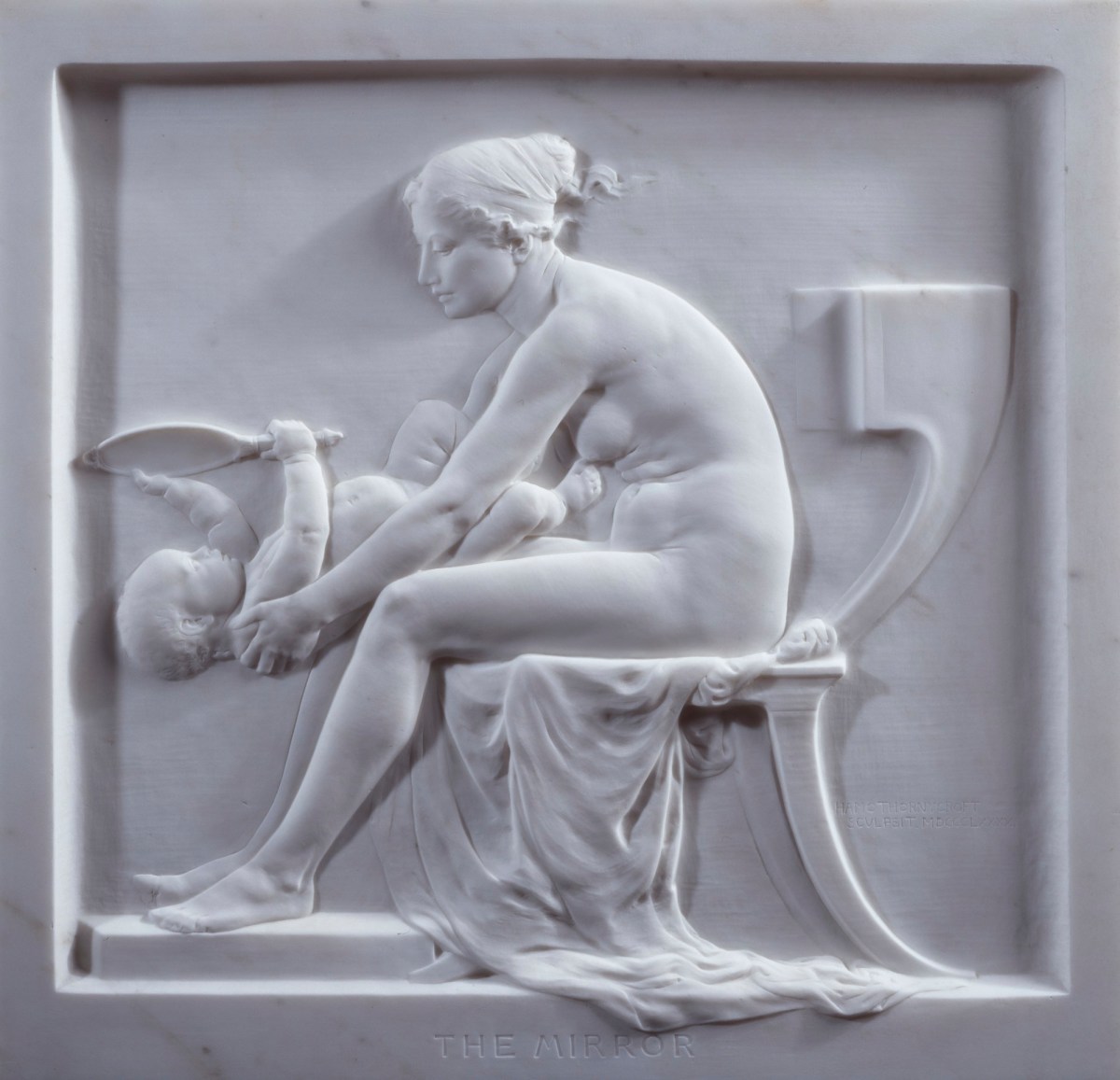
Sir Hamo Thornycroft RA, The Mirror, 1890.
Marble relief in velvet covered wooden frame. 740 mm x 765 mm, Weight: 86 kg. © Photo: Royal Academy of Arts, London. Photographer: Paul Highnam.
This image is not available to download. To licence this image for commercial purposes, contact our Picture Library at picturelibrary@royalacademy.org.uk
The Mirror, 1890
Sir Hamo Thornycroft RA (1850 - 1925)
RA Collection: Art
On free display in Dame Jillian Sackler Sculpture Gallery
Hamo Thornycroft executed The Mirror after returning late in 1889 from several months in Paris as a Juror at the Paris International Exhibition. In September 1889 he began a relief in clay for the marble, which he worked on through October to December of that year (a plaster cast of this model is in Leeds City Art Galleries). Thornycroft’s assistant Smith finished pointing the marble block (which the sculptor had purchased from Lord Leighton) on 24 January 1890 and began to mason it. Thornycroft started carving the block (with no help from assistants) on 1 February 1890, finishing it on 25 March of the same year.
The challenges of working in relief were of great importance to Thornycroft during this period, particularly since his major project during this period was the frieze sculpture for the Institute of Chartered Accountants building on Moorgate Place which he worked on between 1889 and 1892. Thornycroft admired ancient Greek sculpture, which he considered to be simple, refined and ‘stimulating to the imagination’, and he believed the Parthenon frieze in the British Museum to be an exemplar of great sculpture: 'Look at the frieze of the Parthenon, monotonous yet never wearisome, one cannot help seeing it altogether. In mean there is no spot, on which the eye can settle. One can breathe them like the west wind.' The format of The Mirror, moreover, owes much to Greek Stele such as The grave stele of Hegeso in the National Archaeological Museum.
Thornycroft submitted The Mirror as his Diploma Work after his election in 1888. The title works on two levels, as observed by The Magazine of Art when it was exhibited in 1890: "The Mirror,"…[shows]… a seated mother sporting with her baby, who seeks to grasp the mirror which she holds, and in whom the mother sees a reflection of herself.’ (The child was based on Thornycroft’s daughter Joan). By this time Thornycroft was established as Britain’s leading sculptor, and like others associated with the New Sculpture movement he had moved away from a cautious Classicism to embrace the vigorous Realism seen most clearly in his Mower. Accordingly, despite the evident classical influences on The Mirror, nonetheless there is a high degree of naturalism in the treatment of the body, for example in the wisps of hair escaping the mother’s headscarf.
Further Reading
David J. Getsy, 'Animating the Classical: Hamo Thornycroft's Experimentation with the Ideal Statue,1878-1884' in Body Doubles: Sculpture in Britain, 1877-1905 (New Haven & London: Yale University Press, 2004), pp. 43-85
Elfrida Manning, Marble & Bronze: The Art and Life of Hamo Thornycroft, (London: Eastview Editions, 1982), Repr, p. 110, pl. 71, p. 113, p. 205, Cat. 144
'Sculpture of the Year', The Magazine of Art, 1890, pp. 361-366
Object details
740 mm x 765 mm, Weight: 86 kg
Start exploring the RA Collection
- Explore art works, paint-smeared palettes, scribbled letters and more...
- Artists and architects have run the RA for 250 years.
Our Collection is a record of them.



